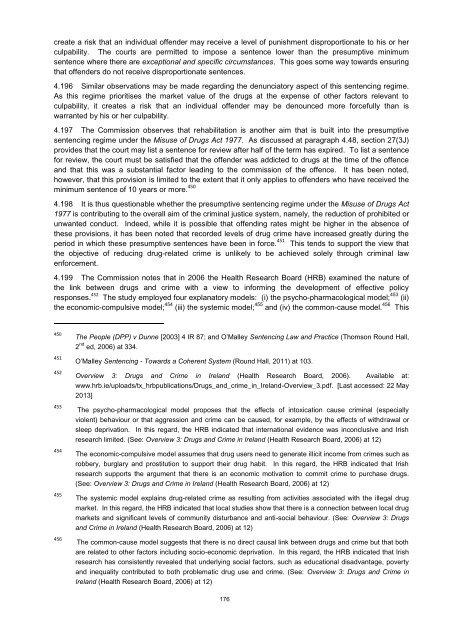Report on Mandatory Sentences - Law Reform Commission
Report on Mandatory Sentences - Law Reform Commission
Report on Mandatory Sentences - Law Reform Commission
Create successful ePaper yourself
Turn your PDF publications into a flip-book with our unique Google optimized e-Paper software.
create a risk that an individual offender may receive a level of punishment disproporti<strong>on</strong>ate to his or her<br />
culpability. The courts are permitted to impose a sentence lower than the presumptive minimum<br />
sentence where there are excepti<strong>on</strong>al and specific circumstances. This goes some way towards ensuring<br />
that offenders do not receive disproporti<strong>on</strong>ate sentences.<br />
4.196 Similar observati<strong>on</strong>s may be made regarding the denunciatory aspect of this sentencing regime.<br />
As this regime prioritises the market value of the drugs at the expense of other factors relevant to<br />
culpability, it creates a risk that an individual offender may be denounced more forcefully than is<br />
warranted by his or her culpability.<br />
4.197 The Commissi<strong>on</strong> observes that rehabilitati<strong>on</strong> is another aim that is built into the presumptive<br />
sentencing regime under the Misuse of Drugs Act 1977. As discussed at paragraph 4.48, secti<strong>on</strong> 27(3J)<br />
provides that the court may list a sentence for review after half of the term has expired. To list a sentence<br />
for review, the court must be satisfied that the offender was addicted to drugs at the time of the offence<br />
and that this was a substantial factor leading to the commissi<strong>on</strong> of the offence. It has been noted,<br />
however, that this provisi<strong>on</strong> is limited to the extent that it <strong>on</strong>ly applies to offenders who have received the<br />
minimum sentence of 10 years or more. 450<br />
4.198 It is thus questi<strong>on</strong>able whether the presumptive sentencing regime under the Misuse of Drugs Act<br />
1977 is c<strong>on</strong>tributing to the overall aim of the criminal justice system, namely, the reducti<strong>on</strong> of prohibited or<br />
unwanted c<strong>on</strong>duct. Indeed, while it is possible that offending rates might be higher in the absence of<br />
these provisi<strong>on</strong>s, it has been noted that recorded levels of drug crime have increased greatly during the<br />
period in which these presumptive sentences have been in force. 451 This tends to support the view that<br />
the objective of reducing drug-related crime is unlikely to be achieved solely through criminal law<br />
enforcement.<br />
4.199 The Commissi<strong>on</strong> notes that in 2006 the Health Research Board (HRB) examined the nature of<br />
the link between drugs and crime with a view to informing the development of effective policy<br />
resp<strong>on</strong>ses. 452 The study employed four explanatory models: (i) the psycho-pharmacological model; 453 (ii)<br />
the ec<strong>on</strong>omic-compulsive model; 454 (iii) the systemic model; 455 and (iv) the comm<strong>on</strong>-cause model. 456 This<br />
450<br />
451<br />
452<br />
453<br />
454<br />
455<br />
456<br />
The People (DPP) v Dunne [2003] 4 IR 87; and O’Malley Sentencing <strong>Law</strong> and Practice (Thoms<strong>on</strong> Round Hall,<br />
2 nd ed, 2006) at 334.<br />
O’Malley Sentencing - Towards a Coherent System (Round Hall, 2011) at 103.<br />
Overview 3: Drugs and Crime in Ireland (Health Research Board, 2006). Available at:<br />
www.hrb.ie/uploads/tx_hrbpublicati<strong>on</strong>s/Drugs_and_crime_in_Ireland-Overview_3.pdf. [Last accessed: 22 May<br />
2013]<br />
The psycho-pharmacological model proposes that the effects of intoxicati<strong>on</strong> cause criminal (especially<br />
violent) behaviour or that aggressi<strong>on</strong> and crime can be caused, for example, by the effects of withdrawal or<br />
sleep deprivati<strong>on</strong>. In this regard, the HRB indicated that internati<strong>on</strong>al evidence was inc<strong>on</strong>clusive and Irish<br />
research limited. (See: Overview 3: Drugs and Crime in Ireland (Health Research Board, 2006) at 12)<br />
The ec<strong>on</strong>omic-compulsive model assumes that drug users need to generate illicit income from crimes such as<br />
robbery, burglary and prostituti<strong>on</strong> to support their drug habit. In this regard, the HRB indicated that Irish<br />
research supports the argument that there is an ec<strong>on</strong>omic motivati<strong>on</strong> to commit crime to purchase drugs.<br />
(See: Overview 3: Drugs and Crime in Ireland (Health Research Board, 2006) at 12)<br />
The systemic model explains drug-related crime as resulting from activities associated with the illegal drug<br />
market. In this regard, the HRB indicated that local studies show that there is a c<strong>on</strong>necti<strong>on</strong> between local drug<br />
markets and significant levels of community disturbance and anti-social behaviour. (See: Overview 3: Drugs<br />
and Crime in Ireland (Health Research Board, 2006) at 12)<br />
The comm<strong>on</strong>-cause model suggests that there is no direct causal link between drugs and crime but that both<br />
are related to other factors including socio-ec<strong>on</strong>omic deprivati<strong>on</strong>. In this regard, the HRB indicated that Irish<br />
research has c<strong>on</strong>sistently revealed that underlying social factors, such as educati<strong>on</strong>al disadvantage, poverty<br />
and inequality c<strong>on</strong>tributed to both problematic drug use and crime. (See: Overview 3: Drugs and Crime in<br />
Ireland (Health Research Board, 2006) at 12)<br />
176
















